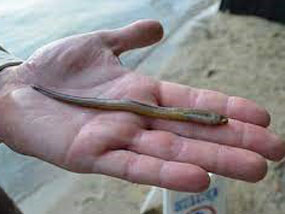Rethinking Detroit River Eels
By Ali Shakoor

Sometimes as fishermen, we use lures or colors that resemble absolutely nothing in nature. I can assure you; I’ve never seen a shiner with the same color scheme as a “Barbie” colored crankbait. Maybe, those colors are meant to catch the eyes of the fishermen, as much or more than the fish. The same can be said of some plastics. Why would a walleye in the Detroit River decide to eat a Lance Valentine Signature Series THUMP! Worm? Yes, it could look like the occasional earthworm that may get washed into the river, but maybe there is something else it may resemble.
Did you know that there are five lamprey species that live in the Great Lakes region? The invasive sea lamprey is the largest of the five and is known to feed on many species of fish and has negative impacts on fish populations. They may grow to about two feet in length. There are also four species of native lamprey in the region. The native species include the parasitic chestnut and silver lamprey.  As adults they feed on the blood and body fluid of fish. The American brook and northern brook lamprey are not parasitic. The two parasitic species may reach about a foot in length. The non-parasitic species reach a length of about six inches in length as adults, does that sound familiar? Along with sea lamprey, the chestnut and silver lamprey live in rivers. As larvae, all five species of lamprey burrow into sediment and feed on particulate matter, algae, and other microscopic organisms. All lamprey become active in spring and build nests in rivers and streams on bottom. Think about that for minute. They are about six inches in length, have long cylindrical bodies, come in a variety of natural colors and live in or near bottom sediment. That sounds just like a THUMP! Worm to me.
As adults they feed on the blood and body fluid of fish. The American brook and northern brook lamprey are not parasitic. The two parasitic species may reach about a foot in length. The non-parasitic species reach a length of about six inches in length as adults, does that sound familiar? Along with sea lamprey, the chestnut and silver lamprey live in rivers. As larvae, all five species of lamprey burrow into sediment and feed on particulate matter, algae, and other microscopic organisms. All lamprey become active in spring and build nests in rivers and streams on bottom. Think about that for minute. They are about six inches in length, have long cylindrical bodies, come in a variety of natural colors and live in or near bottom sediment. That sounds just like a THUMP! Worm to me.
We’ve often talked about “matching the hatch”. This is a classic example of doing just that, and sometimes not being aware of it. Sometimes we use techniques without knowing the “why”, we just know that it works. A vital component of the eight steps is having an understanding of the “why”, along with understanding other vital components of those same eight steps. Here we have multiple prey species that have a spatial and temporal overlap with spawning walleye, that many people aren’t even aware of. This is a classic example of having a successful bait, but not knowing why it is successful. Now you know a bit of ecological information to help in your understanding of why this particular bait is so successful during spring on the Detroit River.